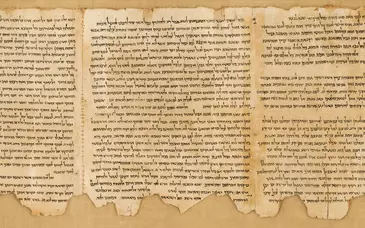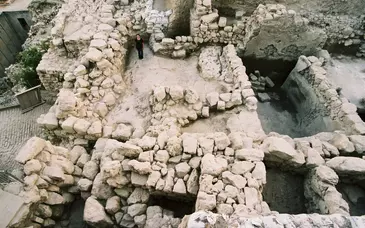Archaeological Data
For more Study See Importance of the Dead Sea Scrolls
Qumran Location
Qumran Caves
Dead Sea Scroll Shrine, Jerusalem
Dead Sea Landscape
Introduction
There has not been an archaeological discovery which has caused such a wave of emotion and excitement as the discovery at Qumran. The Dead Sea Scrolls and the Qumran Community are perhaps the two centres of attention in Biblical archaeology and Scholarship today. Since their discovery in 1947 more books have been written on them than any other single discovery.
Location
Qumran is located nearly three quarters of a mile west of the Dead Sea and 8.5 miles south of Jericho. This site has been made synonymous with the 'City of Salt' in Scripture (Joshua 15:62).
Ruins
Map of Qumran Ruins


The men involved in the excavations were G. L. Harding and Roland de Vaux. During five campaigns between 1951-1956, they uncovered the ruins of an elaborate central building complex. Some of the buildings included towers, assembly halls, kitchens, storehouses, extensive waterway with large cisterns. The variety of structures included stables, workshops, pools for baptizing and three cemetaries.
The Commentary on Habakkuk
The Book of Mysteries
In the floor of one of the rooms was found a jar which was identical with those in which the Bedouin had found the manuscript in Cave I where the Dead Sea Scrolls were found. Obviously there is a connection with the Dead Sea Scrolls and the Qumran Community. The most outstanding find would be the scriptorium or writing room, measuring 43 by 13 feet. In this room were the ruins of a narrow masonry table together with long benches attached to the walls. Also three inkwells were found, one of which contained dried ink. This must have been where many of the DeadSea Scrolls were written. Copies of scripture's were made here as well as interpretations of them.
The structure of the building was made larger than those used for a private dwelling and it also possessed appropriate industrial buildings necessary to the community.
Essenes
There are a number of convincing reasons why the Essene sect occupied the Qumran monastery. The geographical location of the Essene sect described by Josephus and Pliny place them in the general vicinity of En Freshkha. Recent discoveries show that the pottery found in the structures at En el-Ghuweir and En Freshkha are in the same time period as Qumran.
It is apparent that Qumran is one of the several settlements for the Essene sect. They withdrew to the wilderness of Judea because of the prophecy 'The voice of him that crieth in the wilderness, Prepare ye the way of the Lord, make stright in the desert a highway for our God.' (Isaiah 40:3)
According to Josephus representing the Essenes, and the Manual of Discipline representing the Qumram community, both required a two year apprenticeship before admitting women to their order. A number of other regulations as voting, eating seating, and speaking were also common denominators between the Essenes and Qumran.
A most significant similarity between the Essenes and the Qumran community was the practice bathing and baptism. The water was brought down from the spring at Ain Freskha by a water supply system and ran into the city by an aqueduct into a number of pools, cisterns and a reservoir.
From these facts it can easily be established that the community was a monastery and a communal society. The Essene sect occupied the city and placed the Dead Sea Scrolls in the Qumran Caves.
Historical importance
First Occupation
As a result of the finds of pottery and coins in the ruins, the community has been dated from 135 B.C. to A.D. 68. There is also a distinct and separate occupation of the community. The Essenes first occupied the community from about 135 B.C. until their life was interrupted by an earthquake in 31 B.C. This is known because of the report Josephus made of an earthquake which shook Judea in the spring of 31 B.C. and the archaeological evidence of a twenty-inch drop through the eastern end of the community ruins. The Essenes had to move out of this community when their walls and water systems were destroyed. Then about 4 B.C. the community returned; the buildings were repaired, the tower was reinforced, shaken walls were buttressed, new rooms were erected, and industrial kilns were constructed. Thereafter, the secluded life of prayer and study at Qumran was resumed on a larger scale.
Second Occupation
The second period of occupation was by a Roman garrison between 68 A.D. and 86 A.D. Just before the Romans arrived, the members of the community hid their scrolls in the caves around the area.
Last Occupation
The last period of occupation was by the Jewish insurgents during the second war against Rome, A.D. 132-135. The ruins were used for a stronghold or a hiding place.
Qumran reveals some military significance in the fact that they had a tower to defend themselves. It must have been some sort of stronghold because of the Roman garrison's occupation for 18 years.
Economically, the city was self-sufficient which is evident from the archaeological discoveries of the rooms. pottery, kiln, reservoir, mill and all their stores.
Cultural Importance
The cultural importance of the community at Qumran lies in the very community itself. The Essenes built the community with their culture in mind. To explain the culture of the Essenes, their religion must first be examined.
Religious History
The Founder of the community was a priest called the 'The Teacher of Righteousness, to whom God made known all the mysteries of the words of His servants the prophets.'' They looked to a time of God's judgment in the immediate future when the wicked would be punished and the righteous rewarded. They held to a view that the time of the Messiah was at hand. Roman persecution especially by the cross drove them into the wilderness to seek protection and allow them the seclusion they needed to study and copy their scrolls.
Monastery Life
They built the monastery at Qumran and retired there to study the law and await the end of the days. They turned their worldly possessions over to the community as did the early Christians. It is evident also that baptism played an important role in their religious life even teaching repentance as a necessary pre-requisite to baptism. They believed that only the members of their sect could be saved by God, as they were the elect of God. They were governed by very strict disciplinary rules.
The Essenes studied and interpreted scripture which can be seen in the discoveries of the scriptorium and the caves. The caves were very profitable in showing the work of the Essenes. Some of the scrolls which were found were:
The Manual of Discipline
The Damascus (or Zadokite) Document
The Commentary on Habakkuk
The War of the Sons of Light and the Sons of Darkness
The Thanksgiving Psalms
The Book of Mysteries
They led a very communal life made evident in the fact that in the storage room only the tableware of the community was discovered. There was no evidence of cooking utensils here.
Social Life
The social life of the Qumran community can be derived further from the cemetery outside the city walls. Here about 1,0 burials with about 0 burials in the secondary cemeteries. After investigating the site only six female skeletons were found, and all but one were found in the secondary cemeteries. According to Josephus, in some villages the Essenes were married and could have brought them there to bury them. Others say that there were both married and unmarried at the community of Qumran. It is well known that some practised celibacy and the ration of men to women is very small at Qumran.
Religious Importance
New Testament
The discovery of the Essene Community at Qumran will greatly aid in the study of the New Testament. There is now additional evidence of a religious movement within Judaism which was only previously known from the writings of Philo, Josephus and Pliny. This period, from 0 B.C. to A.D. 68 covers precisely the time when Jesus lived, when the gospel was preached and when the early church was being formed. There have been attempts at comparative studies of John the Baptist and Jesus with the Qumran community. It is generally accepted that neither were of the Essene sect.
Old Testament
The Commentary on Habakkuk
The Book of Mysteries
The discovery of the Dead Sea Scrolls at Qumran have revolutionised Old Testament textual criticism. A leather scroll of the complete book of Isaiah was found dating back 1,000 years before the oldest Hebrew text, the Massoretic text. The remarkable fact is the exactness of the two copies supporting the fact that the Word of God has been providentially kept from error. Every book of the Bible was represented except the book of Esther.
These discoveries will also aid in the knowledge of Hebrew lexicography, grammar and syntax along with the Greek translation of the Old Testament. It is difficult to measure the impact that either the Qumran community or the Dead Sea Scrolls has had, or will have on linguistics and biblical studies. It is perhaps the most significant discovery to come out of the middle east in the field of Biblical studies.

